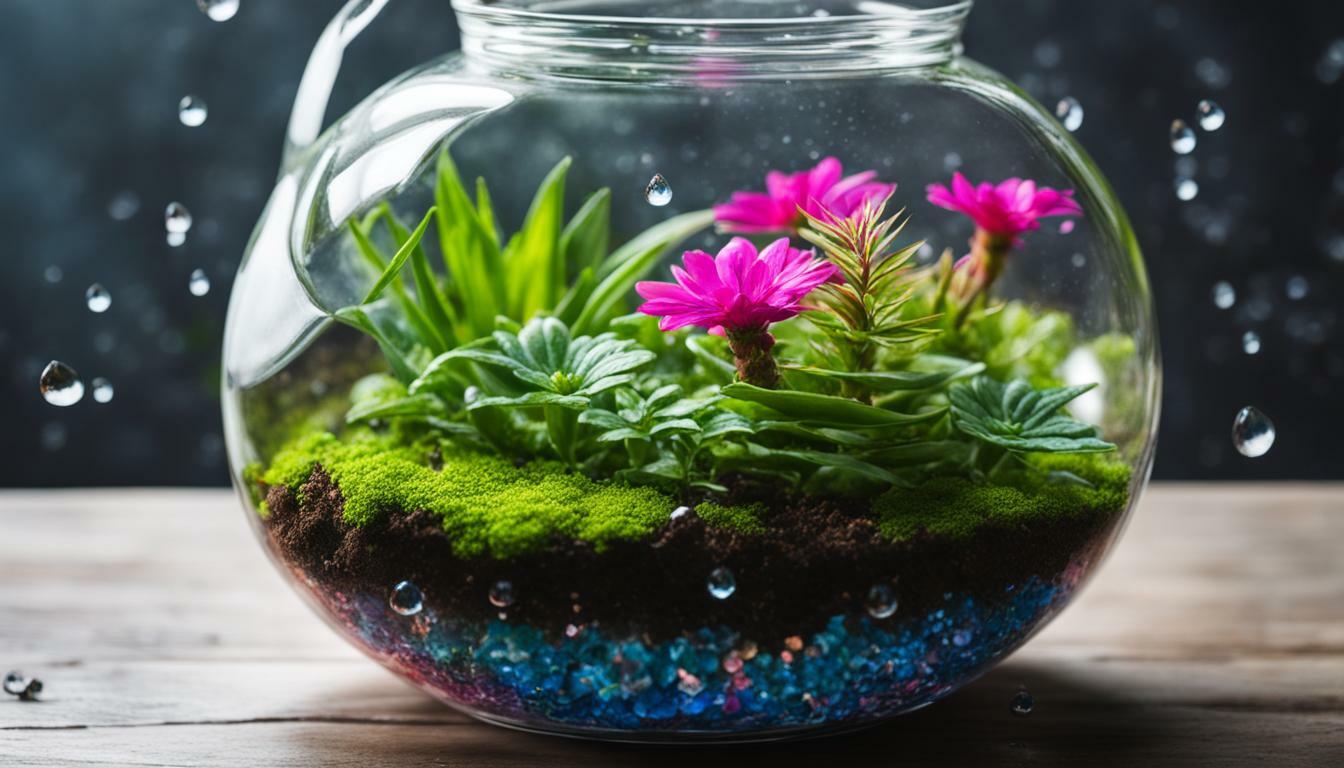Welcome to the ultimate terrarium care watering guide, where we will delve into the essential aspects of nurturing your terrarium to ensure its thriving growth.
Terrariums have become a popular way to display indoor plants, allowing you to bring a touch of nature into your home or office. With a wide variety of tropical or arid plants to choose from, you can create your own miniature garden that requires minimal maintenance. However, to keep your terrarium plants healthy and vibrant, proper care, including watering, is crucial.
When it comes to watering your terrarium, understanding the specific water requirements of your plants is paramount. Different terrarium types, such as closed and open designs, have distinct watering needs. Closed terrariums retain moisture more effectively, requiring less frequent watering compared to open designs. It’s important to research and establish a suitable watering schedule tailored to your terrarium type.
Key Takeaways:
- Proper watering is essential for the health and growth of terrarium plants.
- Research the specific water requirements of your terrarium plants.
- Closed terrariums require less watering than open designs.
- Create a watering schedule based on the needs of your terrarium type.
- Monitor the moisture levels in the soil and the condensation in the terrarium.
Regularly check the moisture levels in the soil to ensure your terrarium plants are not underwatered or overwatered. Additionally, monitor the condensation levels on the walls of the terrarium. High condensation may indicate excessive moisture, while low condensation could indicate a need for more watering.
In addition to proper watering, pruning and cleaning are essential aspects of terrarium maintenance. Pruning helps control the growth of your plants and maintains their appearance, while cleaning removes dust and keeps the terrarium looking fresh.
Lastly, understanding the lighting needs of your terrarium plants is crucial. Most terrariums thrive in bright, indirect light. Ensure your terrarium is placed in a location that provides adequate lighting without exposing the plants to direct sunlight.
By understanding and meeting the specific needs of your terrarium plants, you can create a thriving miniature ecosystem that brings beauty and life into your space.
Understanding Terrarium Watering Needs
Properly understanding the watering needs of your terrarium is crucial for its overall health and longevity. In this section, we will explore various techniques on how to water a terrarium and share essential tips for maintaining ideal moisture levels for your terrarium plants.
When it comes to watering your terrarium, it’s important to consider the specific care requirements of the plants within it. Most terrariums require bright, but indirect light, so be sure to place your terrarium in a location that provides the appropriate lighting conditions. Researching the lighting needs of your plants will help you determine the best placement for your terrarium.
Watering is a vital aspect of terrarium care, and it’s important to check the moisture levels in the soil and the condensation levels in the terrarium. Overwatering can lead to root rot and other issues, while underwatering can result in dried-out plants. To strike the right balance, it’s recommended to water lightly and allow the soil to dry out slightly between waterings. Closed terrariums generally require less watering than open designs, as the enclosed environment helps to retain moisture.
To effectively water your terrarium, consider using a watering can with a narrow spout or a spray bottle to target the soil directly. This helps to avoid water splashing onto the foliage, which can increase the risk of fungal diseases. Additionally, be mindful of the type of water you use – distilled or filtered water is often preferred, as tap water may contain additives that can harm the plants.
By following these watering techniques and guidelines, you can ensure the optimal health and growth of your terrarium plants. Remember to regularly check the moisture levels and adjust your watering routine as needed. With proper care and attention, your terrarium will flourish and bring a touch of nature to any indoor space.
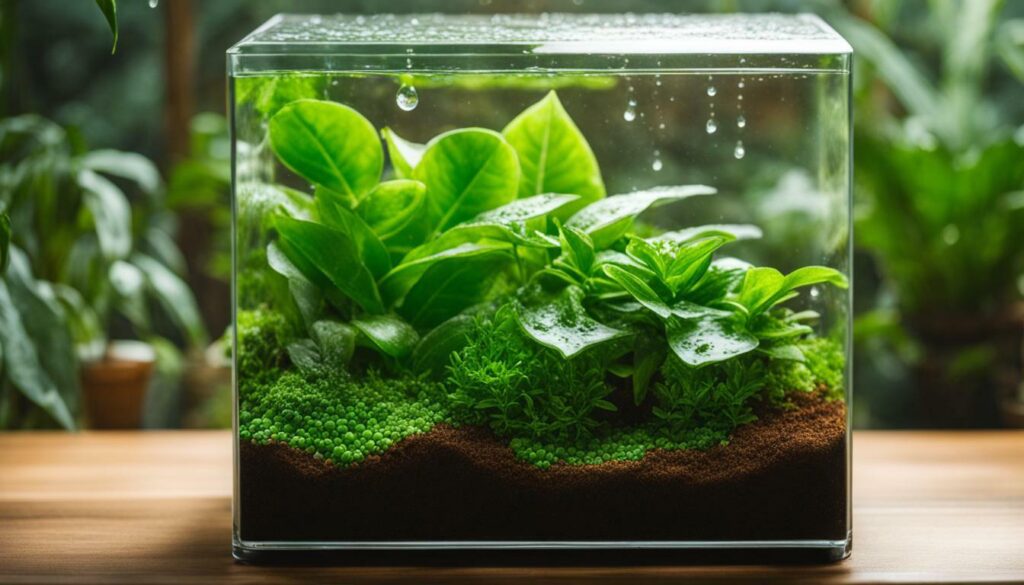
Understanding the watering requirements of different terrarium types is crucial for maintaining the appropriate moisture levels. In this section, we will explore closed and open terrariums, discuss the ideal watering schedule, and provide insights into the recommended watering frequency for each type.
Closed Terrariums: Closed terrariums are sealed environments that create their own mini ecosystems. The enclosed nature of these terrariums means that they require less watering compared to open designs. The moisture inside a closed terrarium is recycled through condensation, creating a self-sustaining system. As a general rule, you should only water closed terrariums lightly, allowing the plants and soil to absorb the moisture from the air. Overwatering can lead to water stagnation and cause damage to the plants.
Open Terrariums: Open terrariums, on the other hand, have unsealed tops or ventilation, allowing for better air circulation. Due to the increased airflow, open terrariums tend to dry out more quickly than closed ones. It is essential to monitor the moisture levels in the soil and water open terrariums accordingly. As a guideline, water open terrariums when the soil feels dry to the touch. However, be careful not to overwater, as excessive moisture can lead to root rot and other plant health issues.
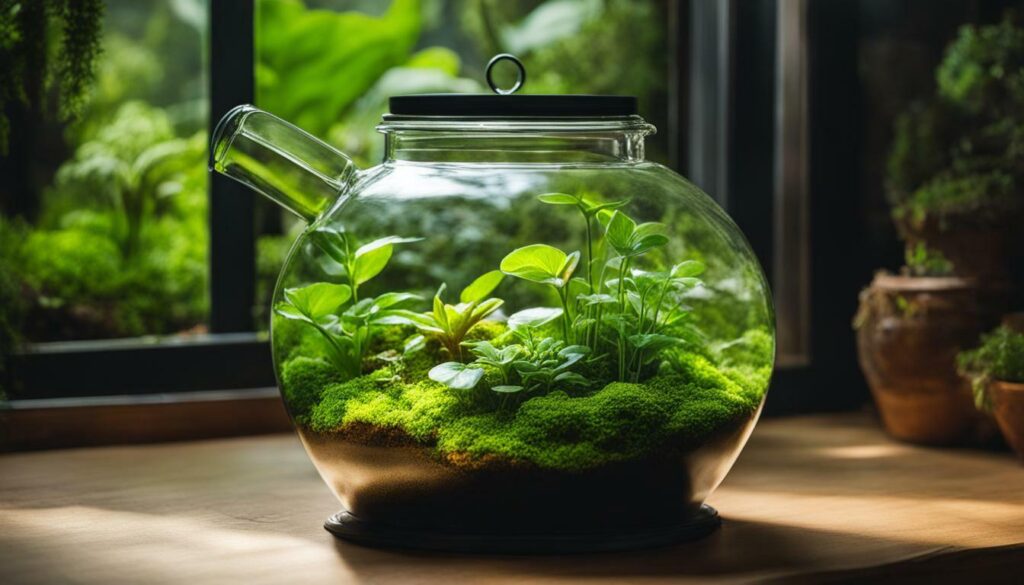
| Terrarium Type | Ideal Watering Schedule | Recommended Watering Frequency |
|---|---|---|
| Closed Terrarium | Water lightly | About once every 2-3 weeks |
| Open Terrarium | Water when soil feels dry | About once a week |
By understanding the watering requirements of different terrarium types, you can ensure that your plants receive the appropriate amount of moisture for their growth. Remember to observe and adjust the watering frequency based on the specific needs of your terrarium plants to maintain a healthy and vibrant miniature garden.
Monitoring Moisture Levels in Terrariums
Monitoring the moisture levels in your terrarium is essential to prevent overwatering or underwatering. In this section, we will guide you on how to check the soil moisture and interpret the condensation levels to ensure your terrarium plants receive the right amount of water.
To check the soil moisture, gently insert your finger about an inch into the soil. If it feels dry, it is time to water your terrarium. However, if it feels damp, it is best to wait before watering again. Remember, it’s important not to overwater your terrarium as it can lead to root rot and other problems.
Another indicator of moisture levels is the condensation on the terrarium walls. Condensation occurs when the moisture inside the terrarium evaporates, then condenses on the cooler walls and lid. While some condensation is normal and indicates a humid environment, excessive condensation may be a sign of overwatering. If you notice droplets constantly forming and no evaporation, it is a good idea to reduce watering.
Table 1: Interpreting Moisture Levels
| Soil Moisture | Condensation Levels | Watering Action |
|---|---|---|
| Dry | Minimal or no condensation | Water your terrarium |
| Damp | Moderate condensation | Wait before watering |
| Soggy | Excessive condensation | Reduce watering and improve ventilation |
By regularly monitoring the soil moisture and condensation levels, you can maintain a healthy balance of hydration for your terrarium plants. Remember to keep a record of your watering schedule and adjust it based on the specific needs of your plants. With these simple monitoring techniques, you can ensure that your terrarium thrives and remains a stunning centerpiece in your home or office.
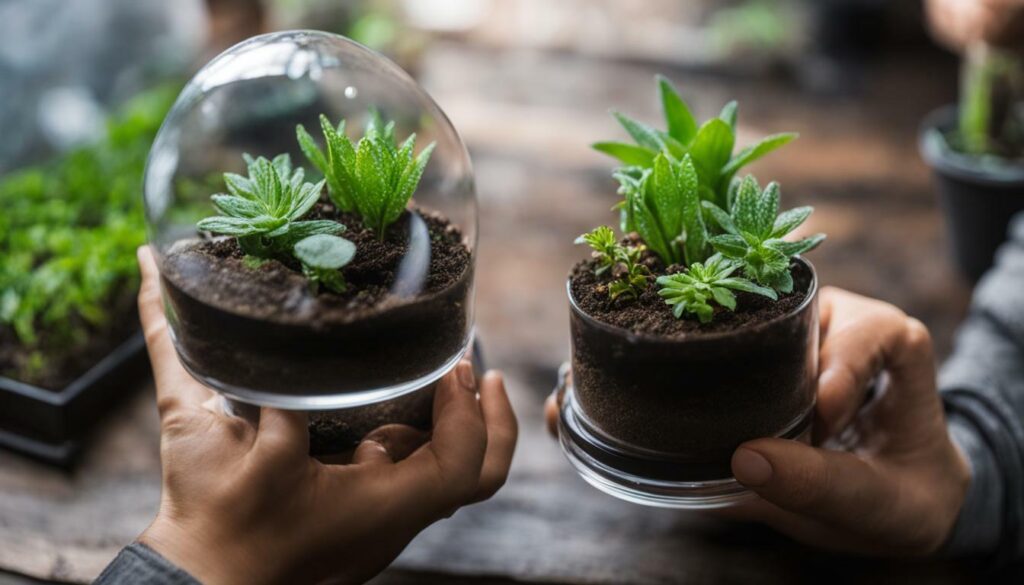
Achieving proper watering techniques is vital for the optimal growth and development of your terrarium plants. In this section, we will explore different methods for watering terrariums and highlight the benefits of watering from the bottom.
When it comes to watering your terrarium, it’s important to strike a balance. Overwatering can lead to root rot and other issues, while underwatering can cause dehydration and wilting. To avoid these problems, it’s crucial to pay attention to the moisture levels in the soil.
One effective method for watering terrariums is to water from the bottom. This technique allows the water to be absorbed through the drainage holes, ensuring that the roots receive proper hydration without overwhelming the soil. To water from the bottom, simply place your terrarium in a shallow dish filled with water, and let it sit for about 10-15 minutes. As the soil absorbs the water from the bottom up, you can ensure that the entire root system is adequately hydrated.
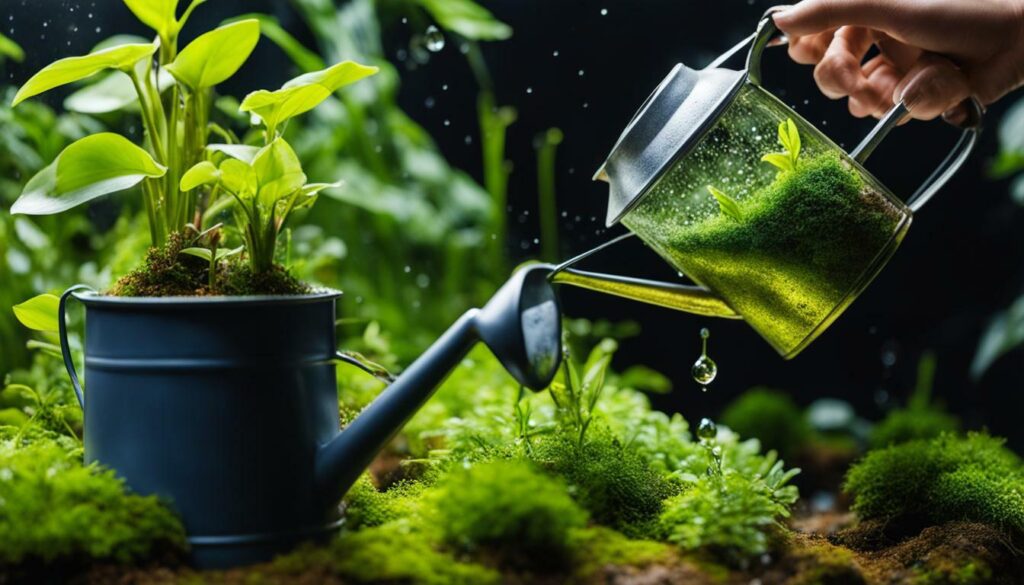
In addition to bottom watering, it’s also crucial to monitor the moisture levels in the soil. You can do this by gently inserting your finger about an inch into the soil. If it feels dry, it’s time to water your terrarium. However, if the soil feels wet or damp, it’s best to wait until it dries out before watering again.
By following these proper watering techniques, you can help your terrarium plants thrive and maintain their health and beauty. Remember to consider the specific watering needs of your terrarium plants and adjust the frequency of watering accordingly. Whether you choose to water from the bottom or use other methods, a mindful approach to watering will ensure the success of your miniature garden.
Pruning and Cleaning for Terrarium Maintenance
Pruning and cleaning are essential tasks in the regular maintenance of your terrarium, ensuring the longevity and aesthetic appeal of your miniature garden. In this section, we will guide you through the proper techniques for pruning your terrarium plants and offer tips on how to effectively clean your terrarium.
Pruning Terrarium Plants
Regular pruning helps maintain the shape and size of your terrarium plants, promotes healthy growth, and prevents overcrowding. When pruning, identify any dead, damaged, or yellowing leaves or stems and carefully trim them off using sharp scissors or pruning shears. Be sure to sterilize your tools before and after each use to prevent the spread of diseases. Additionally, remove any excessive growth that may impede the airflow or sunlight from reaching the rest of the plants. Remember to prune with caution and avoid cutting into healthy parts of the plant. Take your time to shape and trim your plants to suit your desired aesthetic.
Cleaning Your Terrarium
To maintain the beauty and clarity of your terrarium, regular cleaning is necessary. Start by removing any fallen leaves or debris from the soil surface using a soft brush or tweezers. Next, gently wipe the inside of the terrarium walls and any glass or plastic surfaces using a damp cloth or sponge. Avoid using harsh cleaning agents that may damage the delicate plants or leave behind residues. If you notice any mineral deposits or stubborn stains on the glass, a mixture of water and vinegar can be used to gently scrub them away. Remember to rinse the terrarium thoroughly after cleaning to remove any traces of cleaning solutions. Cleaning your terrarium not only enhances its visual appeal but also helps prevent the growth of mold or pests.
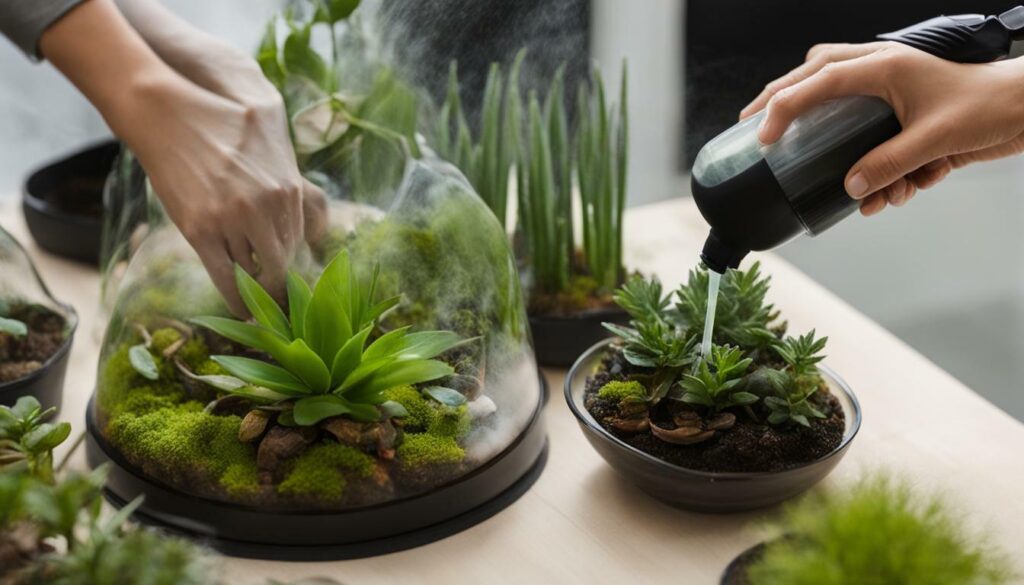
| Pruning Tips | Cleaning Tips |
|---|---|
| Always use clean, sharp tools for pruning to prevent the spread of diseases. | Remove fallen leaves and debris regularly to maintain a clean terrarium environment. |
| Prune damaged or yellowing leaves to encourage new growth and maintain plant health. | Use a soft brush or tweezers to remove debris from between plants and reach tight spaces. |
| Trim excessive growth to prevent overcrowding and ensure proper airflow and light penetration. | Wipe the inside of the terrarium walls and glass surfaces gently with a damp cloth or sponge. |
Terrarium Lighting and Watering
Proper lighting plays a vital role in the health and watering needs of your terrarium plants. In this section, we will explore the lighting requirements for terrariums and explain how lighting influences the watering process.
When it comes to lighting, most terrarium plants thrive in bright, indirect light. Placing your terrarium near a window that receives filtered sunlight is usually ideal. However, it’s important to research the specific lighting needs of the plants in your terrarium, as some may require more or less light. For example, tropical plants generally need brighter light compared to succulents or cacti.
Lighting also directly affects the watering needs of your terrarium plants. The intensity and duration of light exposure influences the rate at which water evaporates from the soil. In terrariums with high light levels, the soil tends to dry out faster, leading to more frequent watering requirements. On the other hand, terrariums placed in low light conditions may need less frequent watering.
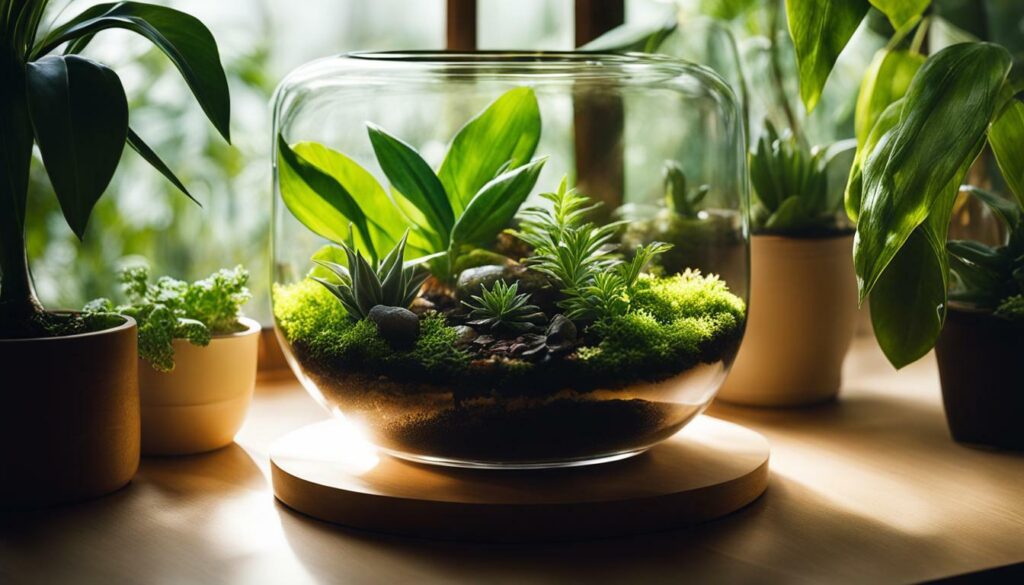
Remember to monitor the moisture levels in your terrarium soil regularly to determine the watering schedule. Stick your finger about an inch into the soil to check for dryness. If it feels slightly damp, it’s a good indication that your plants have enough moisture. However, if the soil feels dry, it’s time to water your terrarium.
Overall, understanding the lighting needs of your terrarium plants is crucial in providing the appropriate care. By ensuring that your terrarium receives the right amount and intensity of light, you can maintain a watering schedule that supports the optimal growth and health of your miniature garden.
What are the best watering practices for maintaining healthy plants in a terrarium?
When it comes to maintaining healthy plants in a terrarium, it’s important to avoid the top terrarium care watering mistakes. Overwatering and underwatering can both be detrimental to plant health. Instead, aim for consistent moisture levels and pay attention to the specific watering needs of each plant species in your terrarium.
Troubleshooting Common Watering Issues
Terrariums may face specific watering issues that can hinder their growth and vitality. In this section, we will identify common watering problems, including overwatering and underwatering, and offer effective solutions to help you troubleshoot these issues.
Overwatering is a common mistake made by terrarium owners. It occurs when the plants receive more water than they need, leading to root rot and other complications. Signs of overwatering include yellowing or wilting leaves, the presence of mold or fungus, and a foul odor. To rectify this issue, first, ensure that your terrarium has proper drainage to prevent water stagnation. If the soil is excessively moist, remove any excess water by gently blotting it with a paper towel. Allow the terrarium to dry out partially before watering again, and adjust your watering frequency accordingly.
On the other hand, underwatering can also be detrimental to terrarium plants. Signs of underwatering include drooping or limp leaves, dried or crispy foliage, and stunted growth. To address this problem, make sure to thoroughly water the terrarium, ensuring that the soil absorbs enough moisture. Monitor the moisture levels regularly and adjust your watering schedule to meet the specific needs of your terrarium plants. Consider using a mister or a spray bottle to provide additional hydration without overwatering.
Additionally, it is essential to be aware of the specific watering requirements of the plants in your terrarium. Different plant species have varying moisture needs, and understanding these requirements is crucial for their overall health. Research each plant’s care instructions and observe any specific signs that indicate whether they are receiving adequate water. By tailoring your watering practices to the individual needs of your terrarium plants, you can ensure their optimal growth and longevity.
| Common Watering Issues | Symptoms | Solutions |
|---|---|---|
| Overwatering | Yellowing or wilting leaves, mold or fungus growth, foul odor | Improve drainage, remove excess water, adjust watering frequency |
| Underwatering | Drooping or limp leaves, dried or crispy foliage, stunted growth | Thoroughly water the terrarium, monitor moisture levels, adjust watering schedule |
Expert Tip:
“To prevent overwatering, always check the moisture levels of the soil before watering. Stick your finger about an inch deep into the soil—if it feels moist, hold off on watering. If it feels dry, it’s time to water your terrarium. Remember, it’s better to slightly underwater than to overwater, as terrarium plants generally prefer slightly drier conditions.”
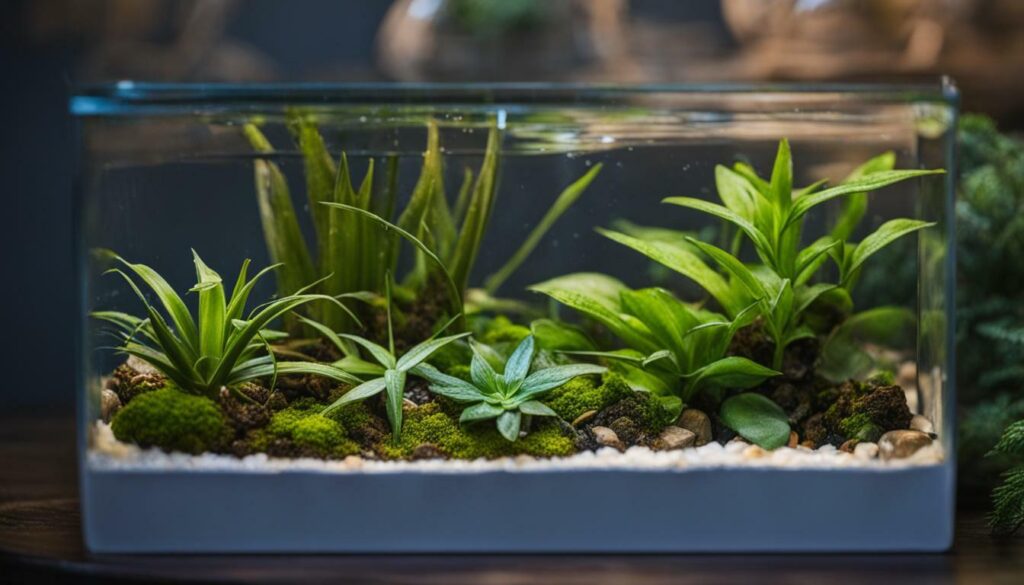
By addressing common watering issues and implementing the appropriate solutions, you can ensure the health and vitality of your terrarium plants. Remember to observe your plants closely and make adjustments as needed. With proper watering practices, your terrarium will flourish, creating a beautiful and thriving miniature garden in your home.
Fertilizing Terrariums: An Essential Aspect of Care
To support the optimal growth and health of your terrarium plants, proper fertilization is crucial. In this section, we will explore the significance of fertilizing terrariums and provide insights into the best practices for providing essential nutrients to your miniature garden.
Fertilizing your terrarium plants is essential because the limited space and closed environment of a terrarium can deplete the nutrients in the soil over time. Without an adequate supply of nutrients, your plants may struggle to thrive and display their full potential.
When it comes to fertilizing your terrarium, it’s important to choose a fertilizer that is suited for the specific needs of your plants. Opt for a balanced fertilizer with equal proportions of nitrogen (N), phosphorus (P), and potassium (K). These three nutrients are essential for plant growth and overall health.
While fertilizing, it’s crucial to follow the instructions provided by the manufacturer and avoid over-fertilization. Too much fertilizer can lead to nutrient burn and damage your plants. Remember, less is often more when it comes to fertilizing terrariums.
| Popular Terrarium Fertilizers | Key Features |
|---|---|
| 1. Indoor Plant Food by Miracle-Gro | ● Balanced NPK ratio for optimal plant growth● Suitable for all terrarium plants |
| 2. Organic All-Purpose Plant Food by Espoma | ● Organic formula for natural plant nutrition● Slow-release nutrients for long-lasting effects |
| 3. Liquid Cactus Plant Food by Schultz | ● Specifically designed for succulents and cacti● Provides balanced nutrition for arid terrariums |
Remember to always read the instructions and dosages recommended by the fertilizer manufacturer. It’s important to fertilize your terrarium plants on a consistent schedule, typically once every 2-4 weeks. However, keep in mind that different plants may have varying nutrient requirements, so it’s essential to research the specific needs of each plant in your terrarium.
The use of organic fertilizers can also be beneficial for terrarium plants. They provide a more sustainable and environmentally friendly approach to feeding your miniature garden while minimizing the risk of chemical buildup in the soil over time.
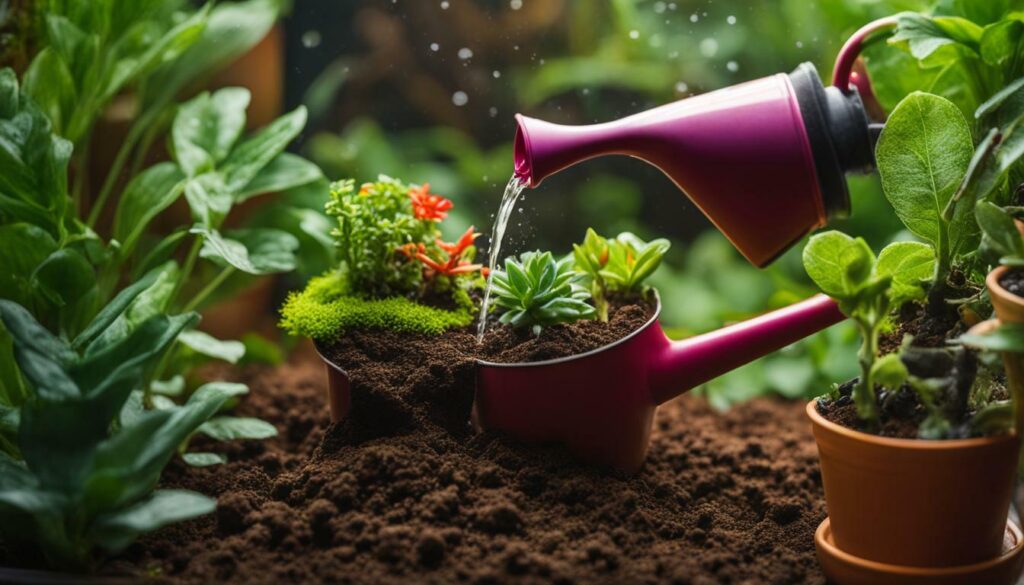
Congratulations! You have now gained indispensable insights into terrarium care and watering. By understanding the watering requirements of your terrarium plants and following the best practices discussed in this guide, you can ensure the thriving growth of your miniature garden.
When caring for a terrarium, it is important to consider the lighting needs of the plants. Most terrariums require bright, but indirect light. Research the specific care requirements of the plants in your terrarium to ensure they receive the appropriate amount of light.
Watering is a vital aspect of terrarium care. To maintain the health of your plants, it is important to check the moisture levels in the soil and the condensation levels in the terrarium. Closed terrariums generally require less watering than open designs. It is crucial to water lightly to avoid water stagnation, which can lead to root rot and other issues.
Proper pruning and cleaning are also essential for the maintenance of your terrarium. Regular pruning helps promote healthy growth, while cleaning keeps your terrarium looking its best. By understanding the specific needs of your terrarium plants and providing them with the appropriate care, you can create a beautiful and thriving miniature garden.
FAQ
How often should I water my terrarium?
The watering frequency for terrariums depends on several factors, including the type of terrarium and the moisture levels in the soil. Generally, it is recommended to check the soil moisture and water lightly when it feels dry. Avoid overwatering to prevent water stagnation.
How do I check the moisture levels in the soil of my terrarium?
To check the soil moisture, insert your finger about an inch into the soil. If it feels dry, it’s time to water. If it still feels moist, hold off on watering to avoid overwatering.
Should I water my closed terrarium less frequently than an open terrarium?
Yes, closed terrariums require less watering compared to open designs. The closed environment helps retain moisture, creating a more humid environment for the plants. Monitor the condensation levels on the terrarium walls to gauge the watering needs.
How should I water a terrarium?
One effective method is to water the terrarium from the bottom. Fill a tray with water and place the terrarium in it, allowing the roots to absorb water through the drainage holes. This ensures that the water is distributed evenly and reaches the plant roots effectively.
How do I prune and clean my terrarium?
Pruning is essential to maintain the health and appearance of your terrarium plants. Trim away any dead or yellowing leaves or stems. For cleaning, gently wipe the inside of the terrarium walls using a soft cloth or paper towel to remove any dust or debris. Avoid using harsh chemicals as they may harm the plants.
What lighting conditions are suitable for terrarium plants?
Most terrariums require bright, indirect light. Place your terrarium near a window with filtered sunlight or use fluorescent or LED lights if natural light is limited. Research the specific lighting needs of your terrarium plants to ensure they receive the appropriate amount of light.
How can I prevent overwatering or underwatering my terrarium?
Regularly monitor the moisture levels in the soil and adjust your watering frequency accordingly. Avoid overwatering by ensuring proper drainage and watering lightly. If you notice signs of underwatering, such as wilting or dry soil, increase the frequency of your watering.

